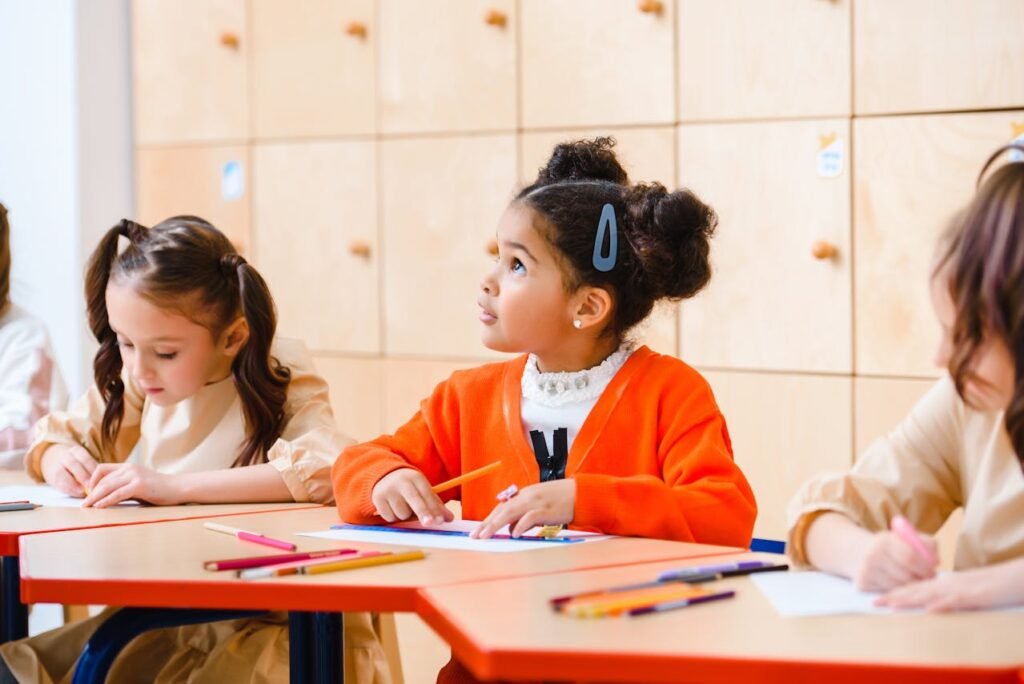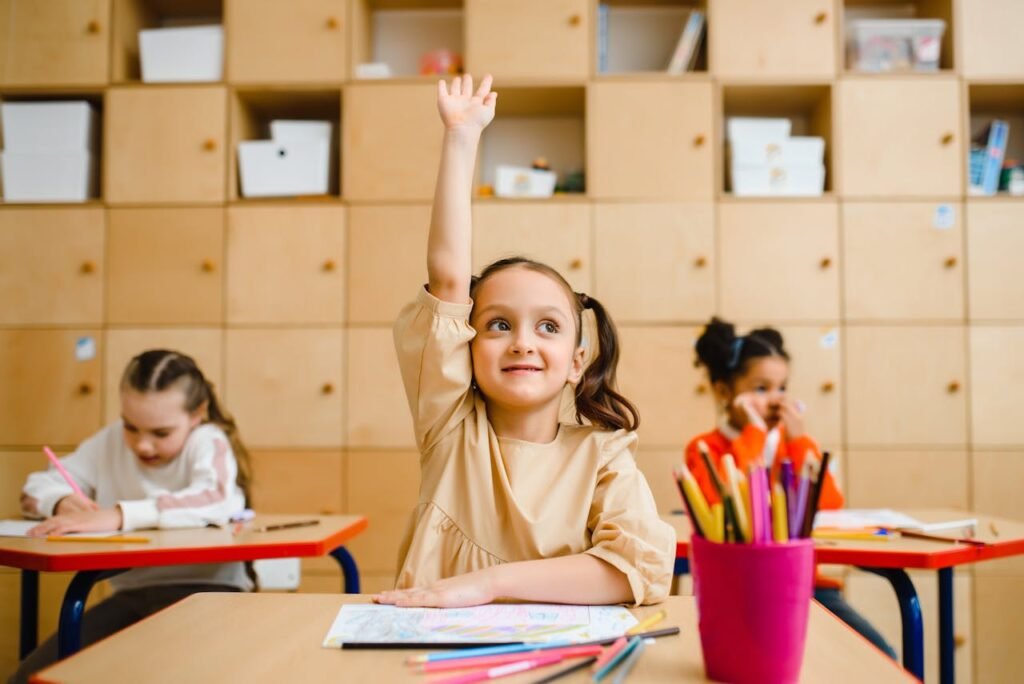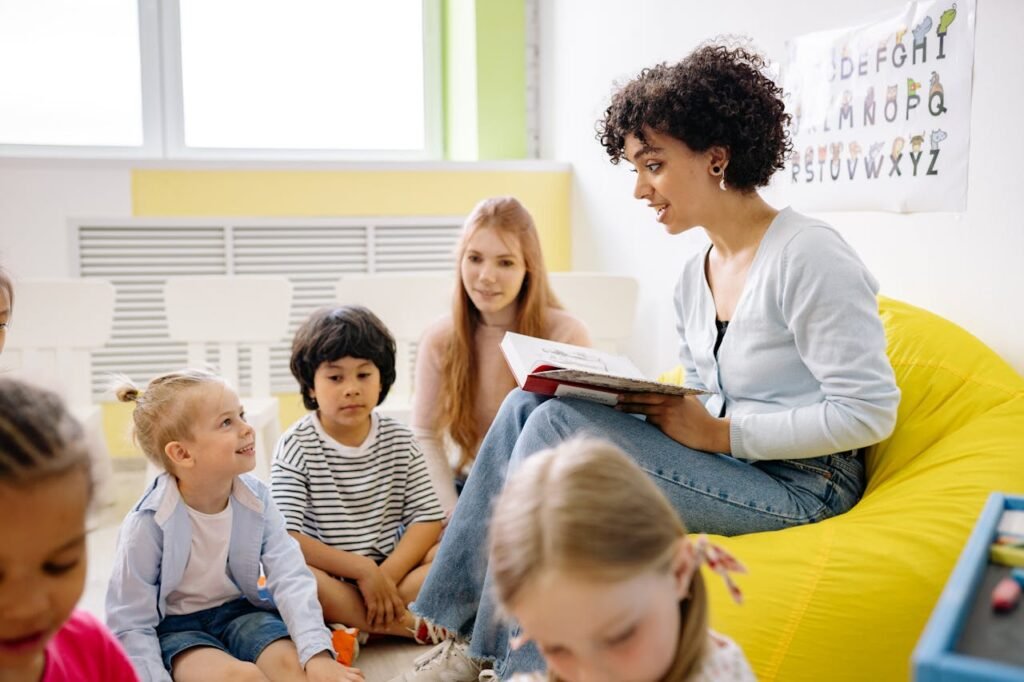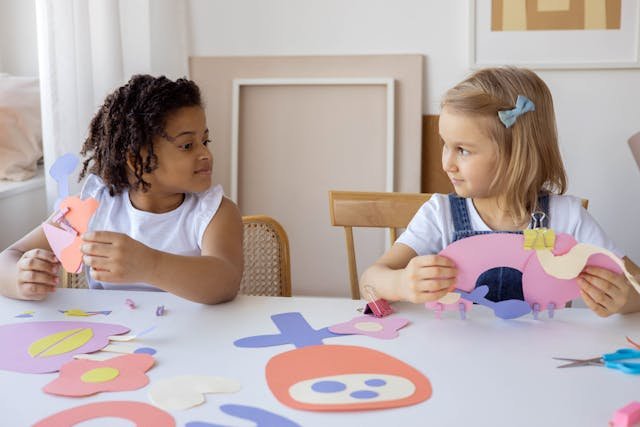Words are powerful. They help us share how we feel, what we think, and what we need. But here’s something amazing — language does more than just help us talk. It actually helps our brain grow.
From the time a baby hears their first “hello,” their brain is working hard to make sense of sounds, words, and meaning. And every time they learn a new word or put a sentence together, they’re building brain power.
Language isn’t just a way to speak. It’s the tool we use to think, remember, solve problems, and learn about the world.
In this article, we’ll explore how language skills and brain growth are connected — and why strong language skills can help your child grow into a smarter, more confident learner. Whether your child is just starting to babble or already writing stories, this connection is shaping how they think, learn, and grow every single day.
How Language Builds the Brain from Birth
From the very first cry to the first “mama” or “dada,” a baby’s brain is working hard to make sense of the world. And one of the most important things it learns early on is language. This learning starts earlier than most people think — even before a baby can talk.
Listening Starts Before Talking
Babies begin learning about language by listening. Even in the womb, they can hear voices and sounds. After birth, every voice, every lullaby, and every word helps their brain grow stronger.
When a parent says, “Good morning!” or sings a soft song, the baby’s brain is lighting up. It’s learning the rhythm, tone, and music of words — all without saying a single word back. This is where language learning truly begins.
Words Are Building Blocks for the Brain
Each new word a baby hears is like a building block. Over time, these blocks form strong connections inside the brain. It’s not just about learning the word “ball” or “dog.” It’s about connecting that word to an object, a feeling, and an action.
For example:
- A baby hears “milk” during feeding time.
- They feel warm, safe, and full.
- Their brain connects the word “milk” with the act of feeding and the comfort that comes with it.
These little moments happen all day, every day — and each one grows the brain a little more.
Repetition Builds Stronger Connections
Babies love hearing the same words again and again. This repetition is not boring to them — it’s powerful. It helps their brain make stronger and faster connections. When you say “peekaboo” for the hundredth time, you’re not just playing — you’re helping your child’s brain grow sharper.
That’s why repeating words like names, colors, and actions during play, meals, or bedtime helps children learn language faster and better.
Conversations Start Early — Even Without Words
Many parents don’t realize that they’re already having conversations with their baby, even before the baby can talk. When a baby coos and you respond with a smile or words like, “Are you talking to me?” — that’s a conversation. It teaches your child about taking turns, listening, and responding.
This back-and-forth builds brain skills such as focus, memory, and problem-solving. It also teaches children that communication is about connection — not just words.
The Brain Grows Fast in the Early Years
In the first few years of life, a child’s brain grows faster than at any other time. By age 3, their brain is already about 80% the size of an adult brain. That’s why these early years are so important for language learning.
The more words, stories, songs, and conversations a child hears in those first few years, the stronger and more flexible their brain becomes. These early experiences shape how they think, learn, and communicate for the rest of their life.
Why Talking to Babies Matters So Much
Some people think babies are too young to understand, so they don’t talk to them much. But the truth is, babies who hear more words in their early years usually grow up with better language and thinking skills. Even simple talk — like saying “Let’s change your diaper now” or “What a lovely day!” — helps the brain grow.
When babies hear language, their brains start making strong pathways that help them understand more and more each day. This is how they build the base for learning to talk, read, write, and even solve problems later. Talking, singing, reading books — even just chatting about what you see around you — gives your child a head start in life.
Language Helps Kids Think Better
Words are not just for talking. Words help us think. When a child knows more words, they can explain what they feel. They can ask questions when they’re curious. They can solve problems more clearly. They can also understand what others are saying to them.
Imagine a child who doesn’t know the word “angry.” When something upsets them, they might scream or hit. Now imagine a child who can say, “I’m angry because you took my toy.” That child is not just talking. They are thinking, understanding, and handling their emotions better. This is why learning language is not just about speaking — it’s about helping the whole brain grow.
What the Brain Does During Language Learning

Learning language might look simple on the outside — a child hears a word, says it back, and then uses it later. But inside the brain, something truly amazing is happening. It’s a full team effort between different parts of the brain, all working together in perfect timing.
Let’s take a closer look at what the brain actually does when a child is learning language.
Step 1: Listening and Sound Recognition
It all starts with the ears. When a child hears a word, the sound goes into the brain. One special part of the brain — called the auditory cortex — starts working to recognize the sound. It’s not just hearing the noise. It’s figuring out, “What word is that? Have I heard it before?”
Even tiny babies can tell the difference between sounds in different languages. That’s how powerful the listening part of the brain is. It begins learning patterns and rhythms of speech long before a child can talk.
Step 2: Figuring Out the Meaning
Next, another part of the brain steps in — the part that handles understanding. This area tries to answer the question, “What does that word mean?”
Let’s say a child hears the word “apple” while seeing a red fruit on the table. The brain links the sound of the word with the shape, color, smell, and taste of the fruit. Over time, the child doesn’t just know what the word sounds like. They know what it means in real life.
This is where learning turns into memory. The brain stores this word and its meaning so the child can use it again later.
Step 3: Finding the Right Words to Say
When a child wants to speak — maybe they want to ask for that apple — their brain starts searching for the right words. This part is like a little word library inside the brain. The brain picks the words it needs and puts them in the right order: “I want apple.”
This takes practice. At first, it might just be “apple” or “want apple.” But with time, the brain learns how to build better and clearer sentences.
Step 4: Speaking Out Loud
Now comes the final step — saying the words out loud. Another brain area tells the lips, tongue, and voice how to move to make the right sounds.
This might sound simple, but it’s actually one of the trickiest parts. A lot has to go right for a word to come out clearly. That’s why it takes time and practice, and why kids sometimes say funny or mixed-up words when they’re still learning.
The more they practice, the stronger the brain becomes at controlling these muscles and speaking clearly.
How Language Supports School Learning

Language isn’t just for reading or speaking. It plays a big part in all school subjects. Whether it’s solving a math problem, understanding a science experiment, or writing a history answer, children need strong language skills to do well.
In math, for example, children need to understand what the question is asking. Words like “more than,” “less than,” “total,” or “difference” are key to solving problems. Without understanding these, even simple problems can feel confusing.
In science, children must listen carefully, understand instructions, and explain what they see. If they’re doing an experiment about plants, they need to describe changes, make guesses, and write what they learned. All of that depends on using clear language.
Even in subjects like art or physical education, language helps. It helps kids follow instructions, share ideas, and work with others. So, when we help children grow their language skills, we’re helping them learn everything better.
Language and Behavior: A Surprising Connection
When children don’t have the words to express themselves, they often show their feelings through actions. This is very common, especially in younger kids. A child might throw a toy, cry, or shout — not because they’re bad — but because they don’t know how to say what’s wrong.
As their language improves, their behavior often improves too. A child who can say, “I’m tired,” “I need help,” or “That made me upset,” is much more likely to stay calm and solve problems. They don’t need to act out — they can speak out.
Language gives children power. The power to explain, to ask for help, to share feelings, and to listen to others. This is one of the most important steps toward becoming more patient, more thoughtful, and more in control of their actions.
Language and Emotions: Growing From the Inside Out
Language doesn’t just help children understand school — it helps them understand themselves. When a child can say, “I feel nervous about the test,” they start learning how to deal with feelings in a healthy way. This is the beginning of emotional intelligence.
When children know the words for emotions — like “happy,” “frustrated,” “jealous,” or “proud” — they begin to understand what those feelings mean. And when they understand them, they’re more likely to handle them well. They can also start to understand what others are feeling, which helps them become kinder friends and better team players.
This is why so many experts say: Language is the bridge between the mind and the heart.
How to Grow Language and Thinking Skills Together

You don’t need fancy tools or special lessons to help a child build language and brain power. In fact, some of the best ways to help are the simplest. The magic often happens in daily moments — during meals, car rides, bedtime, or playtime.
Talk, Even About Small Things
Talk to your child as much as you can. Talk about the weather, what you’re cooking, or what you see out the window. These small chats help your child learn how to describe the world. The more they hear, the more they understand. And when they try to answer or ask questions, they are building both language and thinking skills at once.
For younger children, describe what they are doing: “You’re stacking the blocks so high!” For older children, ask questions that make them think: “Why do you think the moon looks bigger tonight?” These talks build their ability to think clearly and speak with confidence.
Ask Open Questions
Open questions are questions that don’t have just one answer. Instead of asking, “Did you like the story?” try asking, “What was your favorite part?” or “Why do you think the lion felt scared?” These questions help children explain ideas, make guesses, and form opinions.
When they answer, listen with care. Don’t rush them. Let them find the right words, even if it takes time. This builds both patience and thinking strength.
Read, Every Day if You Can
Reading is one of the best ways to grow language and brain skills together. Even with little ones, picture books help build words and imagination. As children get older, reading helps them follow ideas, remember details, and learn new ways to speak and think.
Talk about the stories after reading. Ask, “What do you think will happen next?” or “How would you feel if that happened to you?” These little chats turn reading into thinking.
Tell Stories and Encourage Them to Do the Same
Storytelling is powerful. It helps children practice memory, order, emotion, and creativity — all at once. You can tell a story from your own life, or make one up together. Then ask your child to tell you a story, too. It doesn’t have to be perfect. Even a simple story like “I went to the park” is a great start.
When children tell stories, they learn how to express ideas clearly. They also build imagination and learn how to understand the world from different points of view.
How Parents Can Help Language and Brain Growth at Home

You don’t need to be a teacher to help your child grow smarter. With just a few simple changes to your everyday routine, you can boost your child’s language skills — and support their brain growth too. Here’s how:
1. Make Time for Talking
You don’t need to sit down and teach. Just talk during everyday moments. While cooking dinner, folding laundry, or walking to the store, talk about what you see, hear, and feel.
Say things like:
- “Look at that blue truck! Where do you think it’s going?”
- “I love the smell of these cookies. What do they remind you of?”
These little moments build big brain power.
2. Listen More Than You Talk
Kids love being heard. Ask your child questions and give them time to answer. Even if they speak slowly or make mistakes, don’t rush them. Listening patiently tells your child that their voice matters — and that makes them want to speak and share even more.
Try asking:
- “What was the best part of your day?”
- “How did you feel when that happened?”
3. Play Word Games Together
Games like “I Spy,” rhyming games, or silly word stories help kids play with sounds, meanings, and patterns. This builds stronger language and thinking at the same time — and it’s fun!
Even made-up games like “Let’s invent a word” can boost creativity and vocabulary.
4. Explore the World of Books
Make books part of your child’s daily routine. Keep books around the house. Let your child choose what they like. Read aloud together — even with older kids. And don’t just read the words. Talk about the pictures, the characters, and the feelings.
Ask:
- “Why do you think she made that choice?”
- “What would you do if you were there?”
5. Celebrate Effort, Not Just Perfection
When your child tries to say something new or uses a big word, celebrate it. Don’t worry if it’s not perfect. Say things like:
- “Wow! That’s a great way to explain it!”
- “I love how you used that word!”
This builds confidence and helps your child enjoy using language.
How Debsie Helps Children Grow Smarter Through Language

At Debsie, we understand that language is the key that unlocks learning in every subject. That’s why we build language into everything we teach — from math and science to geography, history, and even coding. Whether a child is learning to add, learning about animals, or learning how the Earth works, we help them talk about it, think about it, and understand it deeply.
Our goal is simple: to help every child grow into a smart, curious, and confident thinker.
Teaching That Matches How the Brain Grows
We don’t believe in one-size-fits-all teaching. Kids of different ages — and even different moods — learn in different ways. That’s why our lessons are designed to match each child’s stage of brain growth. We make sure they feel understood, supported, and challenged in just the right way.
For younger children, we focus on playful words, storytelling, songs, and hands-on fun. These tools help them grow strong language skills without even knowing they’re learning. For older kids and teens, we encourage discussion, debate, explanation, and writing — tools that strengthen critical thinking and help them express big ideas clearly.
Learning That Feels Like Play
Children learn best when they’re having fun. At Debsie, we turn learning into a joyful adventure. Every course is built with games, stories, interactive tools, and creative tasks that invite children to use words — and their brains — in exciting ways.
For example, in a science class, a student might not just learn what a plant is. They’ll describe it, ask questions about it, tell stories about it, and even create their own plant journal. This mix of language and thinking turns passive learning into powerful brain-building.
Real Teachers, Real Conversations
All Debsie classes are led by expert teachers who know how to talk with children — not just at them. We believe every question is important. Every voice matters. And every child should feel heard.
Our teachers don’t just deliver lessons. They ask, they listen, they respond, and they guide. This back-and-forth conversation builds confidence, improves speaking and listening skills, and deepens understanding.
Even shy kids start to open up. And as they talk more, they learn more — not just about the topic, but about how to think, express, and grow.
A Path That Grows With Your Child
Whether your child is five or fifteen, Debsie grows with them. Our programs are carefully built to support language and thinking through every stage of childhood and teen years. From early reading and storytelling to writing essays, discussing history, or solving complex math problems — we help children use language as their tool for learning, creating, and succeeding.
At Debsie, language isn’t just a subject. It’s the heart of learning.
Conclusion: Helping Kids Grow From the Inside Out
Language is not just something children learn — it’s something they live. It helps them think, feel, connect, and grow. When we support a child’s language skills, we’re not just helping them speak better. We’re helping them become confident problem-solvers, careful listeners, kind friends, and curious learners.
The brain is most ready to grow when kids are young. And language is one of the most powerful tools we have to shape that growth. Every word they hear, every story they tell, and every conversation they have is helping them become the strong, thoughtful, and successful person they are meant to be.
At Debsie, we believe in the power of words. That’s why every part of our program — from science and math to coding and history — is built to grow both the brain and the child. With real teachers, joyful lessons, and learning that feels like play, Debsie gives your child more than just knowledge. We give them the language and tools to grow a better future.
💡 Ready to help your child grow smarter, more curious, and more confident?
📚 Sign up for a Debsie free trial class today — and let’s start building their brain, one word at a time.
Your child’s journey to smarter learning starts here.
Read Next:
